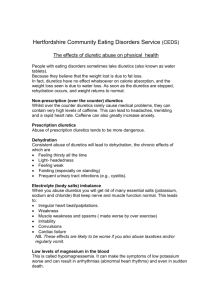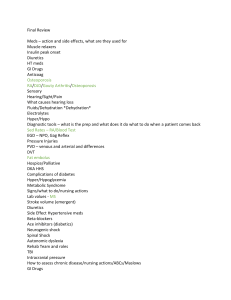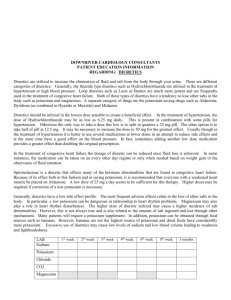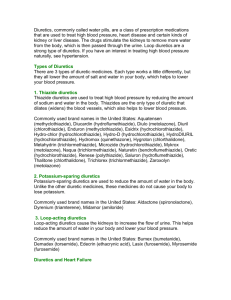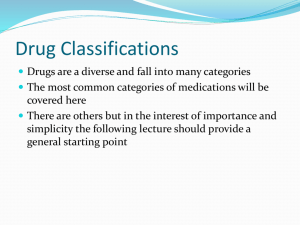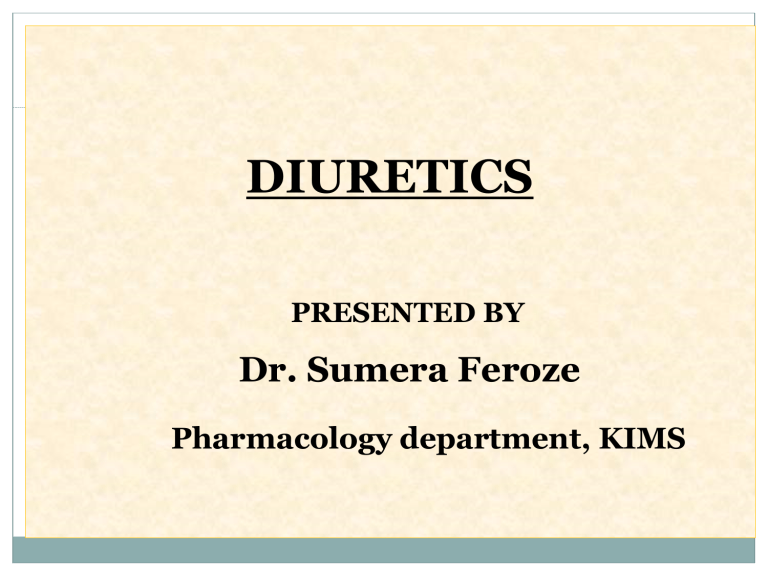
DIURETICS PRESENTED BY Dr. Sumera Feroze Pharmacology department, KIMS DIURETICS DEFINITION : These are drugs which cause a net loss of Na+ and water in urine There are several categories of diuretics. All diuretics increases the excretion of water from body. CLASSIFICATION Diuretics are Classified as: 1. High ceiling /Loop diuretics… 2. Thiazides. 3.Carbonic anhydrase inhibitors. 4.Potassium –sparing diuretics. 5.Osmatic diuretics. 6.Low ceiling diuretics. DIURETICS CLASSIFICATION 1.HIGH EFFICACY DIURETICS: (Inhibitors of Na+,K+,2Cl- cotransport) (a) Sulphamoyl deravatives: Furosemide. Bumetanide. Torasemide. (b) Phenoxyacetic acid derivative: Ethacrynic acid. MEDIUM EFFICACY DIURETICS 2.Medium efficacy diuretics : ( Inhibitors of Na+,Cl- symport) (a) Benzothiadiazines(THIAZIDES): Hydrochloro thiazide. Benzthiazide. Hydroflumethe thiazide. Ciopamide. (b) Thiazide: Chlorthalidone. Metolazone. Xipamide. Indapamide. WEAK OR ADJUNCTIVE DIURETICS 3.Weak or adjunctive diuretics: (a) Carbonic anhydrase inhibitors: Acetazolamide. (b) Potassium –sparing diuretics: (i)Aldosterone antagonist: Spironolacton Eplerenone. (ii)Inhibitors of renal epithial Na+ channel: Trimterene. Amiloride. (c) Osmotic diuretics: Mannitol. Isosorbide. Glycerol. (d) Xanthines: Theophlline. ANTI- DIURETICS 1.Anti diuretic homone(ADH) and its analogues: Vasopressin. Desmopressin. Lypressin. Terlipressin. 2.Diuretics: Thiazides. Amiloride. 3. Miscellineous: Chlorpropamide. Carbamazepine. MECHANISM OF DIURETICS MECHANISM OF ACTION MECHANISM OF ACTION OF LOOP DIURETICS INDICATIONS AND SIDE EFFECTS MECHANISM OF THIAZIDE DIURETICS POTASSIUM- SPARING DIURETICS OSMOTIC DIURETICS PHARMACOLOGICAL ACTIONS OF DIURETICS HIGH CEILING/LOOP DIURETICS High ceiling diuretics may cause a substantial decrease upto 20%of the filtered load of Nacl and water. Loop diuretics such as FUROSEMIDE inhibits the body’s ability to reabsorb sodium at the ascending loop in NEPHRON. THIAZIDES Thiazide diuretics such as Hydrochlorothiazide act on the distal convoluted tubule and inhibits the sodiumchloride symporter leading to retention of water in the urine. Frequent urination is due to the increased loss of water. The long term anti –hypertensive action is based on the thiazides which decrease preload and blood pressure. CARBONIC ANHYDRASE INHIBITORS Carbonic anhydrase inhibitors inhibits the enzyme carbonic anhydrase which is found in proximal convoluted tubule. This results in several effects including biocarbonate retention in the urine. Potassium retention in urine. Decreased sodium absorption. Eg: Acetazolamide. Methazolamine. POTASSIUM-SPARING DIURETICS These are diuretics which do not promote the secretion of potassium into the urine. Potassium is retained and not lost as much as with other diuretics. The term potassium sparing refers to an effects rather than a mechanism or location. Eg: Aldosterone antagonists Spironolactone Which is a competitive antagonist of aldosterone. Aldosterone adds sodium channels in the cells of collecting duct and late distal tubule of the Nephron. Spirnolactone prevents aldosterone from entering the cells, and preventing sodium reabsorption. Eg: Eplerenone. Potassium canrenonate. Epithelial sodium channel blockers Eg: Amiloride. Triamterence. OSMOTIC DIURETICS The compounds as Mannitol are filtered in the glomerulus, but cannot be reabsorbed. Their presence lead to an increases in the osmolarity of the filtrate. To maintain osmotic balance ,water is retained in the urine. Glucose like mannitol behave as an osmotic diuretic. Glucosuria causes a loss of hypotonic water & Na+, leading to a hypertonic state with signs of volume depletion. Such as Hypotention,Tachycardia. LOW CEILING DIURETICS The low celing diuretics are used to indicate an diuretic has a rapid flatting dose effect curve. It refers to a pharmacological profile ,not a chemical structure. MEDICINAL USES Diuretics are used to treat 1. Heart failures. 2.Liver cirrhosis. 3.Hypertension. 4.Certain kidney diseases USES AND SIDE EFFECTS OF DIURETICS REFERENCES Essential of medical pharmacology by KD Tripathi,7th edition. Pharmacology by H.P Rang and M.A Dale. Pharmacology and Pharmacotherapeutics R.S.Satoskar and S.D.Bhandarkar.

